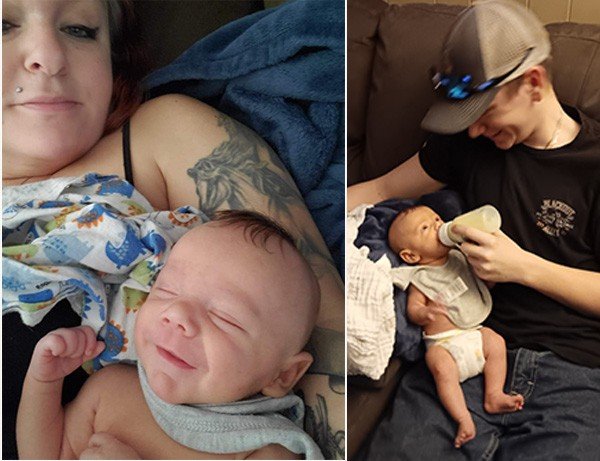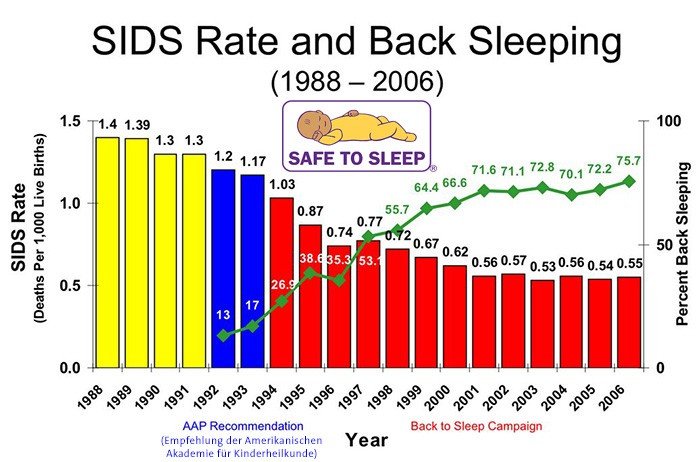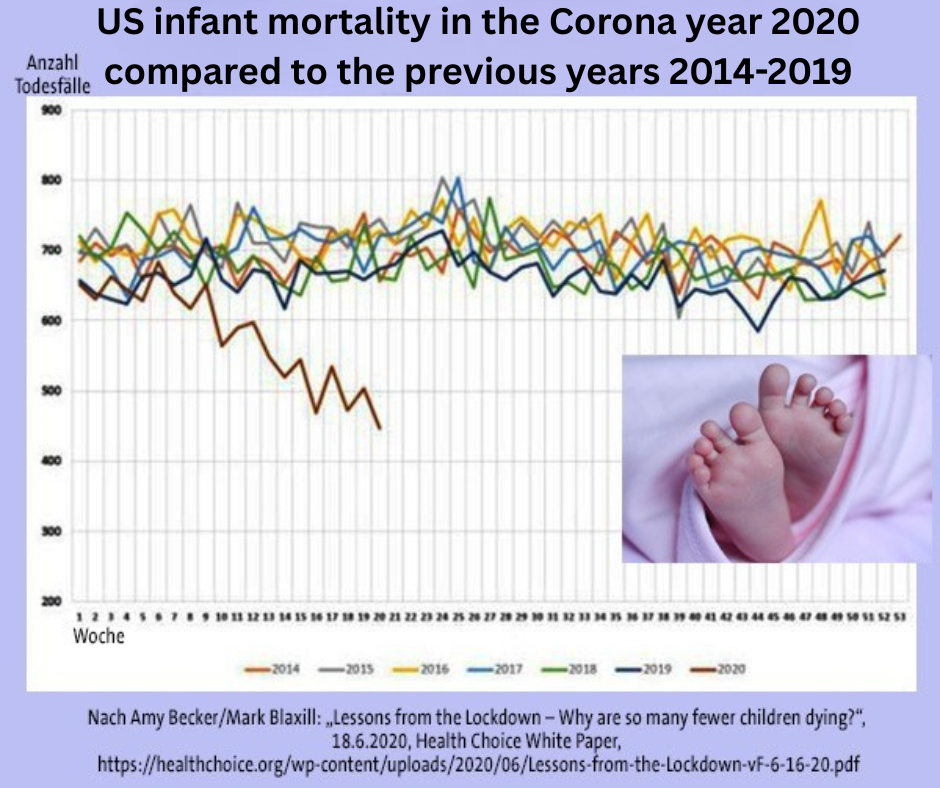by Dr.Harald Wiesendanger– Klartext
What the mainstream media is hiding
Two perfectly healthy babies die suddenly overnight. Their parents are arrested because they failed to put their child in a ‘safe sleeping position’. The charge: negligent homicide. This has happened several times in the USA. Could this happen in Germany, too?

On the morning of 8 May 2024, Gina Strause, a 40-year-old mother from Lebanon County in the US state of Pennsylvania, wants to feed her three-month-old son Gavin. When she looks into his cot, she immediately realises that something is wrong. The baby is not responding. He is cold and has turned blue.
She immediately calls the emergency services. Until they arrive, she desperately tries to revive her boy.
In vain.
What did the infant die of? The autopsy report cites ‘complications due to suffocation’ as the cause of death.
Police officers promptly arrive at Gina Strause’s home and question her and her father, David. In their report, they note that they found loose objects in the cot, ‘such as blankets and soft toys’.
According to the mother’s statement, she breastfed her baby at around 11:30 p.m. She then laid Gavin on his stomach in his cot because he was a ‘tummy sleeper’ and covered him with a blanket. Before David Strause leaves for work at 5:30 the next morning, he checks on his child. He is lying on his stomach and moving a little. To get him back to sleep, the father gently pats him on the bottom.
In an interview with the online news portal PennLive, Gina explains that she usually put Gavin to sleep on his back, but he had gotten into the habit of turning onto his stomach.
During questioning, the parents admit that after the birth, they received a leaflet with medical information about ‘safe sleeping practices’ to prevent sudden infant death syndrome (SIDS) during visits to the doctor. It stated that the baby should lie on its back and sleep in the same room as the parents. The cot should be kept free of bumpers and soft toys.
Because the parents did not follow these guidelines, they are charged with negligent homicide, ‘reckless endangerment of another person’, and ‘endangering the welfare of children.’ To cover legal and trial costs, they have set up a GoFundMe page.

Little Gavin with his mum, Gina (left), and his big brother.
‘Recklessly endangered, negligently killed’?
Natalee Rasmus, a 17-year-old mother from Nanticoke in Luzerne County, also in Pennsylvania, has had a similar experience. When she lifts her four-week-old daughter Avaya Jade out of her cot on the morning of 23 October 2022 to get her ready for a paediatrician appointment, her little body is stiff and cold.
A coroner determines the cause of death as ‘suffocation by mechanical compression’.
During police questioning, Natalee admits that she had received recommendations for safe sleeping for babies from medical staff and in prenatal classes, but had ignored them. Instead, she had placed her baby face down in a bassinet with a Boppy pillow that had a warning label saying ‘Do not use for sleeping.’ (1)
The young mother is charged with ‘third-degree murder,’ which is when someone is killed unintentionally but ‘with reckless disregard for human life.’ In Pennsylvania, this carries a prison sentence of up to 40 years.
Natalee Rasmus remains in custody until the outcome of the still ongoing legal proceedings. She is unable to pay her bail, which has been set at $25,000.
In both cases, the prosecution points out that the babies’ medical records contained signed statements from the parents stating that they had been informed about precautions against sudden infant death syndrome. This is required by a 2010 Pennsylvania law, which obliges hospitals, birth centres and medical service providers to give new parents information materials from the national ‘Safe to Sleep’ campaign and ask them to confirm receipt of these materials.
Candice Christa Semidey, 25, from Virginia, also became a scapegoat: in 2014, she was charged with murder after swaddling her baby and laying it on its stomach. She pleaded guilty to negligent homicide and child neglect. Initially sentenced to five years in prison, she was eventually given a three-year suspended sentence.
Parents rightly pilloried?
Nancy Maruyama, executive director of Sudden Infant Death Services of Illinois, finds such charges shocking: ‘Prosecuting affected parents is a crime because they have already suffered the worst loss imaginable.’ Since 1968, her organisation has been offering parents prevention, support and bereavement counselling.
Lawyers also shake their heads at such accusations and their drastic consequences. The death of the baby was clearly ‘a tragic accident with no criminal intent to harm or kill,’ explained Natalee Rasmus’ court-appointed defence lawyer.
US medical journalist and vaccination critic Neil Z. Miller, author of Vaccines: Are They Really Safe and Effective?, comments indignantly: “Parents of a sleeping baby who dies in the middle of the night should never be charged with murder. It’s just cruel. (..) Should parents really be obliged to follow every “recommendation” from their doctor or the Safe to Sleep campaign? Would we prefer doctors to raise our babies instead of parents? Were other possible causes of death considered, such as vaccinations?”
A transparent diversionary tactic from the fatal consequences of vaccination?
In a well-written article, Miller provides an overview of the history of the diagnosis ‘sudden infant death syndrome’ (SIDS). In it, he states: The dramatic increase in SIDS cases coincided with the first mass vaccination campaigns. The national Safe to Sleep programme was launched after more and more mothers and fathers became concerned that the deaths could have been caused by vaccinations. The campaign sought to dispel this suspicion. It drummed into parents that babies who sleep on their backs or sides are less likely to die in their sleep. Those most at risk of SIDS were said to be ‘tummy sleepers’.
Statistics seem to support this correlation. Between 1992, when the Safe to Sleep propaganda campaign gained momentum, and 2001, SIDS deaths reportedly fell by a whopping 55%. (2) In the United States, there were 4,895 cases in 1992 – twelve years later, in 2004, there were reportedly only 2,247. (3)

SIDS rate and back sleeping from 1988 to 2006. With graphs like this, the US Department of Health and Human Services attempts to ‘prove’ that sudden infant deaths have nothing to do with vaccinations, but rather with unsafe sleeping positions.
However, parallel to the decline in SIDS cases, the mortality rate due to ‘suffocation in bed’, ‘other suffocation’, ‘unknown and unspecified causes’, and ‘unknown causes’ rose significantly.
Why? Because of ‘code shifting’ – the classification system had been changed without further ado. From then on, SIDS deaths were no longer classified as SIDS by medical experts, usually coroners, but were placed in one of the other conceptual pigeonholes.
A study published in the journal Pediatrics came to the same conclusion: deaths that had previously been labelled as SIDS were now simply attributed to other non-SIDS causes, such as suffocation. But essentially, these were still cases of sudden infant death. Such tricky reclassification accounted for more than 90% of the decline in SIDS rates. This finding was confirmed by several other studies in reputable journals. (4) ‘From 1999 to 2015, the SIDS rate in the United States fell by 35.8%, while the number of infant deaths from accidental suffocation rose by 183.8%,’ reports Neil Miller.
Research by the medical news service Scripps Howard News Service confirms Miller’s findings. ‘We conducted a comprehensive study of how infant deaths are investigated in the United States.’ The editorial team based its findings on documents provided by the US health authority CDC. ‘The records contained details of the sudden deaths of 40,239 infants, half of whom died in the 1990s and the rest in a five-year period from 2000 to 2004.’ This revealed ‘statistical manipulation’ and ‘deliberate efforts to make SIDS disappear – on paper.’ The review found “enormous differences in the way infant deaths are investigated and classified. According to the data, the SIDS rate is 12 times higher in Mississippi than in New York.
Most experts agree that such large differences stem from the way deaths are classified, not from the way infants died. The differences are sometimes even greater from county to county within a state because medical examiners take very different approaches to determining the cause of infant mortality in their areas. (…) In some states and cities, SIDS cases have virtually disappeared in recent years – but a closer look at the data makes it clear that thousands of these lives were not “saved” at all, but lost under a different name.”
The reason for this statistical manoeuvre is obvious: nearly 80% of SIDS deaths reported to the Vaccine Adverse Event Reporting System (VAERS) – a US reporting system for vaccine side effects that has been in place since 1990 – occurred within seven days after vaccination. (5)
Coincidence? Why don’t babies die just as often seven days before that?
Before modern vaccination programmes, ‘cot death’ was so rare that it did not even appear in infant mortality statistics. That only changed when the United States launched a series of vaccination campaigns in the 1960s. For the first time, most US children received multiple doses of vaccines against DPT, polio, measles, mumps, and rubella. Shortly thereafter, in 1969, ‘sudden infant death syndrome’ became a medical term. As paediatric neurologist William Torch of the University of Nevada in Reno noted in 1982, two-thirds of infants who died of SIDS had been vaccinated against DPT before their death. Of these, 6.5% died within 12 hours of vaccination, 13% within 24 hours, 26% within 3 days, and 37%, 61% and 70% within 1, 2, and 3 weeks, respectively. (6)
The RKI is playing tricks
The much-cited ‘token study’ on the safety of infant vaccinations organised by the Robert Koch Institute illustrates how brazenly scientists and authorities play tricks to deliver convenient statistics. (7) Its grandiose claim: it was supposed to comprehensively record all unexplained SIDS cases in children aged between two and 24 months who died between summer 2005 and summer 2008 – and investigate whether these deaths were related to previous vaccinations. The financing of the study alone was suspicious: For a sponsorship fee of 2.5 million euros, the manufacturers of two vaccines to be tested, Sanofi Pasteur and GlaxoSmithKline (GSK), bought the right to be ‘informed immediately of any relevant results or assessments’ and to ‘have the opportunity to comment scientifically on the texts intended for publication’ before they were published.
Only 254 cases were included in the evaluation, in which affected parents were willing to complete an extensive questionnaire. However, of the 667 mothers and fathers whose children died during the study period, two-thirds refused to participate, despite repeated attempts to contact them – understandably so. After such a painful loss, who is eager to satisfy the curiosity of data collectors?
To make matters worse, the ‘token study’ managed to deliver two diametrically opposed findings at the same time: the official one and one that only came to light when the basic data was analysed – the RKI hid it in the 160-page long version of the study report, which it only made available in English. As expected, the German short version gave the all-clear: the vaccines are safe – the deaths are apparently due to inattentive, careless parents. In doing so, the RKI highlighted insignificant but convenient details in its reporting; and instead of simply counting SIDS cases, it ‘weighted’ them until convenient conclusions emerged.
On closer inspection, the RKI data actually shows that:
– In the first 14 days after vaccination, a case of SIDS is three times more likely than in the following weeks.
– Three days after a six-fold vaccination, the risk of death is 2 to 3 times higher, and after a five-fold vaccination, it is as high as 8.1 times higher.
– During the second year of life, the probability of dying within 72 hours of vaccination increases by almost 14 times.
If the state of research really refutes skeptics, why do affected parents encounter massive resistance when they insist on finding out the true cause of death of their vaccinated babies? Helga Rühl, board member of ‘Parents for Vaccination Information’ (EFI) and herself an affected mother, has experienced that they ‘have a harder time than Don Quixote fighting windmills.’ In the mid-1990s, she submitted a petition to both the Petitions Committee of the Federal Republic of Germany and her state government to introduce a reporting requirement for sudden infant death, to investigate the temporal proximity to previous vaccinations, and to carry out autopsies on deceased children as a matter of principle. Near-SIDS cases were to be included. Her petition was rejected twice.
A fatal combination of several factors occurring at a critical stage of development could make some infants susceptible to toxic components in vaccines. In the first months of life, the nervous system is still immature, and arousal mechanisms – i.e., waking up when there are breathing problems – do not yet function optimally. Underdeveloped liver enzyme pathways may make it difficult for some babies to break down toxins that are injected into them. External stressors such as overheating, passive smoking, infections, and CO2 rebreathing in poorly ventilated environments affect them far more severely than older children. Taken together, all of these factors can create ‘The Perfect Storm’ that brings about a deadly catastrophe.
Are parents in this country facing the same situation as in the United States?
‘The supine position is the safest sleeping position for babies to prevent sudden infant death syndrome’: Several institutions in Germany also promote this recommendation – from the Federal Centre for Health Education (BZgA) to the German Society for Paediatrics and Adolescent Medicine (DGKJ) and the ‘Gesund ins Leben’ network, to the Child Protection Association dksb.de, the Children’s Health Foundation, the Green Cross and the German Midwives Association.
Can parents in this country be prosecuted if they disregard these recommendations and their baby dies as a result?
To date, no court ruling has been made against parents in Germany in connection with SIDS. However, lawyers point out that this could change in exceptional cases, as under certain circumstances, criminal behaviour may well be involved.
There is no legal obligation to follow medical recommendations – they are not legally binding. The right to raise their children lies with the parents; they are therefore free to decide how to care for and look after their child.
However, parents have a duty of care. They are legally obliged to ensure the well-being and safety of their child (Section 1626 and Section 1631 of the German Civil Code (BGB). If they disregard generally accepted safety rules, such as placing the baby on its back, judges could consider this a gross breach of their duty of care.
What criminal consequences might this have?
If, for example, a baby suffocates because it was lying on its stomach on a pillow – and the parents accepted this despite being informed – they could be accused of negligent homicide (Section 222 of the German Criminal Code). The four prerequisites for this are: breach of duty, causality, foreseeability and avoidability. This is punishable by a fine or, in cases of gross negligence, up to five years in prison.
If parents systematically endanger their child over a long period of time – e.g. by repeatedly allowing them to sleep in conditions that experts and judges consider extremely dangerous – this can be considered a violation of their duty of care (Section 171 StGB).
So much for legal theory. In German legal practice, there has not yet been a single criminal case of this kind. Instead, the youth welfare office usually conducts an investigation, especially if it is a tragic isolated case and there are no signs of neglect or intent. Police investigations following sudden infant death are common, but mainly to rule out foul play. Criminal convictions are rare – they usually require massive and demonstrable breaches of duty.
Incidentally, does parental duty of care not include sparing one’s offspring from deformities as far as possible? Babies who sleep predominantly on their backs are more likely to develop flattened backs of the head. Since the ‘Safe to Sleep’ campaign was launched, unilateral and bilateral skull deformities have increased by 400 to 600% (8): In ‘oblique head’ (plagiocephaly), one side of the back of the head is flattened, the forehead and ear are slightly shifted forward, and the head appears rhomboid or parallelogram-shaped; in ‘short skull’ (brachycephaly), the back of the head is flattened on both sides, making the head appear shorter and wider. Between 20 and 30% of all babies now develop visible deformities of this kind in their first year – although these are harmless to the brain, they are anything but aesthetic.
By sleeping on their backs, babies also spend less time in the prone position (‘tummy time’), which means they exercise their neck and upper body muscles less. ‘According to reports,’ summarises The Guardian, ‘putting babies to sleep on their backs has led to a generation of toddlers who may never learn to crawl, or only do so very late.’ (9)
Premature celebrations?
The fact is that, for the time being, parents in Germany do not need to fear legal wrangling if they position their babies in their cots differently than experts recommend.
However, it may be premature to breathe a sigh of relief. Parents who have not caused their little ones to suffocate to death by placing them in the wrong sleeping position, but who have allegedly shaken them to death, are experiencing the extent to which our so-called constitutional state will go to help the pharmaceutical industry cover up vaccine damage. (10)
Many such cases are documented by the association IN-ES in its book Shaken Baby Syndrome – Violence or a Consequence of Vaccination? (2018): “Taking away your own child! The family is torn apart. Nothing is the same anymore. A great emptiness. Shock. Fear. This is exactly what many parents have already had to experience when their child was taken away from them on the grounds of abuse. There are parents who do physically and psychologically abuse their children – unforgivably. However, many parents are wrongly accused by doctors, courts, and youth welfare offices. This is because vaccinations can also trigger violent-like symptoms. However, other causes are usually not investigated! In the vast majority of cases, exclusionary diagnostics are not performed,d and vaccinations are categorically denied as the cause. Yet it is precisely this distinction that determines whether the child remains with its parents. Many parents who are wrongfully portrayed as criminals give up and settle with the court. In most cases, the father is punished and scarred for life.”
‘Secure positioning’: an absurd imposition
How, pray tell, are parents supposed to ensure that their baby remains lying on their back for hours on end after they have laid them down in this position? Surely this only works in the very first month of life, when their muscles and nerves are not yet mature enough.
And after that? Strap them in?
In fact, babies change their sleeping position several times during the night – how often depends on their age, stage of development, and the respective sleep phase. Among 3,188 infants who were four weeks old, this was observed in 56% of cases. Babies go through sleep cycles lasting 40 to 45 minutes. They wake up briefly during the transitions between light and deep sleep – at this moment, a change of position often takes place unconsciously. At just three months old, some babies turn from their back to their stomach for the first time – others only manage this after six months.
By the time the unspeakable ‘corona pandemic’ hit, attentive parents should have realised how closely vaccinations and SIDS are linked. Especially during lockdowns, when vaccination appointments were cancelled, there was a sudden drop in the number of child deaths.

From the outset, the Safe to Sleep campaign was almost unrivalled in its absurdity. Since humans have existed – i.e. for at least hundreds of thousands of years – their offspring have slept in all kinds of positions, including on their stomachs. Why did the prone position become deadly for newborns on a massive scale only when mass vaccinations began?
The recommendation to sleep on your back is by no means as ‘evidence-based’ as its propagandists claim. In 2022, a systematic research review included 54 studies on the supine position involving a total of nearly 475,000 infants. How many studies indicated that this sleeping position can reduce the risk of sudden unexpected infant death? Only one. According to the review, ‘there is little to very little evidence for this.’
Incidentally, the Safe to Sleep campaign was based on a recommendation by the American Academy of Pediatrics (AAP), the world’s leading professional organisation for paediatrics. Founded in 1930, it represents over 67,000 paediatricians, researchers, and professionals. Its recommendations are not only valid in the USA, but also influence guidelines around the globe. Its sponsors include Pfizer, Merck, Eli Lilly, Genentech (Roche Group), GlaxoSmithKline, Moderna and Sanofi – all vaccine manufacturers. Officially, the annual contributions per company range from £10,000 to over £50,000; in 2017, Pfizer contributed £150,000.
But that’s not all: it is likely that almost every single one of the 17 AAP board members receives pharmaceutical money for consulting, research, writing, or lecturing. Five- to six-figure donations are quite common in the industry. (11)
Such ‘partnerships’ naturally have ‘no influence on the objectivity of our content,’ the AAP asserts on its website. Isn’t it always astonishing how much money Big Pharma is willing to spend to not buy medical institutions?
Notes
(1) A Boppy pillow is shaped like a horseshoe. Originally developed as a breastfeeding aid, it is now also used to prop up, lay down, or support babies.
(1) https://www.thebump.com/news/safe-to-sleep-program-cut, https://www.nytimes.com/2020/04/17/parenting/baby/what-causes-sids.html#:~:text=Before%20the%201960s%2C%20healthy%20infants,%2C%20however%2C%20was%20a%20mystery
(2) L. Bowman/T. Hargrove: “Saving babies: Exposing Sudden Infant Death In America”, Daily Camera 8.10.2007, https://web.archive.org/web/20090226153439/http://www.dailycamera.com/news/2007/oct/08/saving-babies-exposing-sudden-infant-death-in/
(3) https://pubmed.ncbi.nlm.nih.gov/11826207/, https://pubmed.ncbi.nlm.nih.gov/29440504/
(4)Three especially tagic cases here, https://www.klartext-online.info/post/damit-sein-tod-nicht-sinnlos-war here https://www.klartext-online.info/post/blo%C3%9F-ein-piks-zwei-tage-sp%C3%A4ter-tot und here https://www.klartext-online.info/post/6-fach-geimpft-12-stunden-sp%C3%A4ter-tot
(5) William C. Torch: „Diphtheria-pertussis-tetanus (DPT) immunization: a potential cause of the sudden infant death syndrome (SIDS)“, American Academy of Neurology, Vortrag beim 34th Annual Meeting, 25. April – 1. Mai 1982. Neurology 32(4, part 2):A169-170, zit. hier: https://journals.sagepub.com/doi/pdf/10.1177/0960327111407644
(6) More in Bert Ehgartner: Was Sie schon immer über das Impfen wissen wollten (2023), S. 101 ff.
(7) https://journals.healio.com/doi/10.3928/19382359-20200922-02, https://www.theguardian.com/society/2003/jul/08/lifeandhealth.sciencenews, https://pubmed.ncbi.nlm.nih.gov/9086896/
(8) https://www.theguardian.com/society/2003/jul/08/lifeandhealth.sciencenews, https://www.theguardian.com/lifeandstyle/2002/nov/19/healthandwellbeing.health
(9) http://www.bbc.co.uk/news/health-37672451, http://www.shakenbaby.nl/
(10) More in Harald Wiesendanger: Das GesundheitsUNwesen – Wie wir es durchschauen, überleben und verwandeln (2019).
